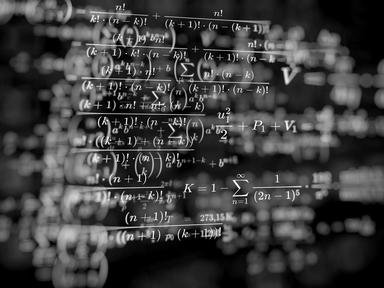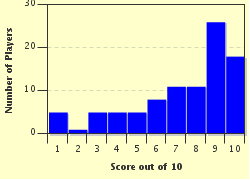Quiz Answer Key and Fun Facts
1. One of the uses of differential calculus is describing how steeply a curve is rising or falling. This is measured by a straight line which touches the curve at exactly one point. What is the name for such a line?
2. The steepness of a curve is described numerically by stating the gradient of a line that touches the curve at a specified point. To calculate its value, you need to first find which of these?
3. You may know him better for discovering the Law of Universal Gravitation, but which scientist and mathematician was one of several to develop a method, still used in introductory calculus classes, for obtaining the derivative of a curve from first principles?
4. After you find the derivative of your curve, and find its value at a point of interest, the value may be positive, negative, or zero. What does it tell you about your curve if the derivative has a value of 0?
5. Over the years, mathematicians have developed some shorthand rules that summarise the results of finding the derivatives of various functions from first principles. One of the first you learn is that the derivative of x^n is nx^(n-1). If there is a coefficient in front of the term, that coefficient gets multiplied by the result. Given that rule, which of these would be the derivative of 5x^4?
6. A polynomial is an expression which is written as the sum of two or more separate terms. When you differentiate such an expression, you just have to differentiate each term separately, and add the results. What is the derivative of the expression 3x^2 + 5x?
7. Now life gets more complicated, and we are faced with a messy expression such as y = (x^3+2x)(3x-1), and wish to differentiate it. In this case, we could simply expand it to write it as a polynomial and differentiate, but that is not always possible, and we need to use which of these rules to find the derivative when two terms have been multiplied together?
8. We are now ready to contemplate a nasty-looking expression such as y = (5x^4 + 4x^3 -7)^2. Once again, I have used an example for which it would be possible to expand it and differentiate the resulting polynomial, but that is not always possible, so we can use the chain rule. This says that we consider y to be made up of two rules. First, there is a rule, z, which does something to the original x. Second, there is another rule, y, which does something to that result. The Chain Rule says that dy/dx = dy/dz x dz/dx. So, in the example above, how could you write y in terms of z?
9. Sometimes we are interested in finding out how quickly the derivative of a function is changing, and not just the original function. Describing motion is an example of this, when we may want to know not only how quickly the object is moving (found using the first derivative of the equation describing its position), but also how quickly its speed is changing (found using the second derivative). What is the name for the property we wish to find in this case?
10. In some situations, we start by knowing what the derivative of the function we actually want is, and need to work out the original function. What is the name for this process?
Source: Author
looney_tunes
This quiz was reviewed by FunTrivia editor
rossian before going online.
Any errors found in FunTrivia content are routinely corrected through our feedback system.

